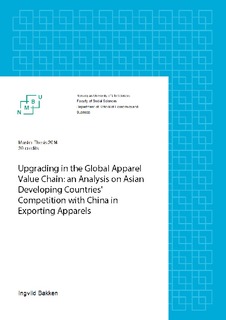| dc.description.abstract | The purpose of this research is to examine how regional suppliers of apparels have performed in the global apparel industry compared to China during the past two decades, and particularly after the phase out of the Multi-Fibre Arrangement (MFA), which up to 2004 applied quotas to exports of clothing in the largest end markets. The speculation prior to the quota phase out was that large increases of Chinese exports would be at the expense of other Asian suppliers. This thesis effort to trace what consequences China’s growth in exports caused for developing countries in Asia in exporting apparels. This analysis has adopted a parsimonious approach from Bernhardt (2013) to examine these effects, concerning three factors for upgrading in the global apparel value chain. To detect economic upgrading, export values and export market shares are analysed from 1993-2012. Product upgrading can be achieved by increasing export prices or export like commodities at a higher price, where prices are used as a proxy for quality. The final upgrading factor is social upgrading, which is analysed by studying real wages and employment.
Major findings is that economic upgrading has been extensive in the country sample, but the other factors has been more difficult to achieve. As expected, China was the biggest winner regarding the apparel upgrading indicators, followed by India. However, most of the regional countries had larger growth in export values and did not lose market share to China after the MFA-phase out. The major reason for this may be the preferential treatment the other countries are granted as developing countries, such as GSP tariffs in the EU and the US. Product upgrading were not easy to trace in the apparel sector, as most countries have shifted to cheaper fabrics to meet price demand from industrialized countries. One interesting finding was that Indonesia, Cambodia and Vietnam operates with same prices for the product categories to the world market and to different markets. These prices were significantly higher than from China, Bangladesh and India. Social upgrading in sweatshops in developing countries were not expected, and although all countries managed to employ more people, real wages only increased in China and India. | nb_NO |
